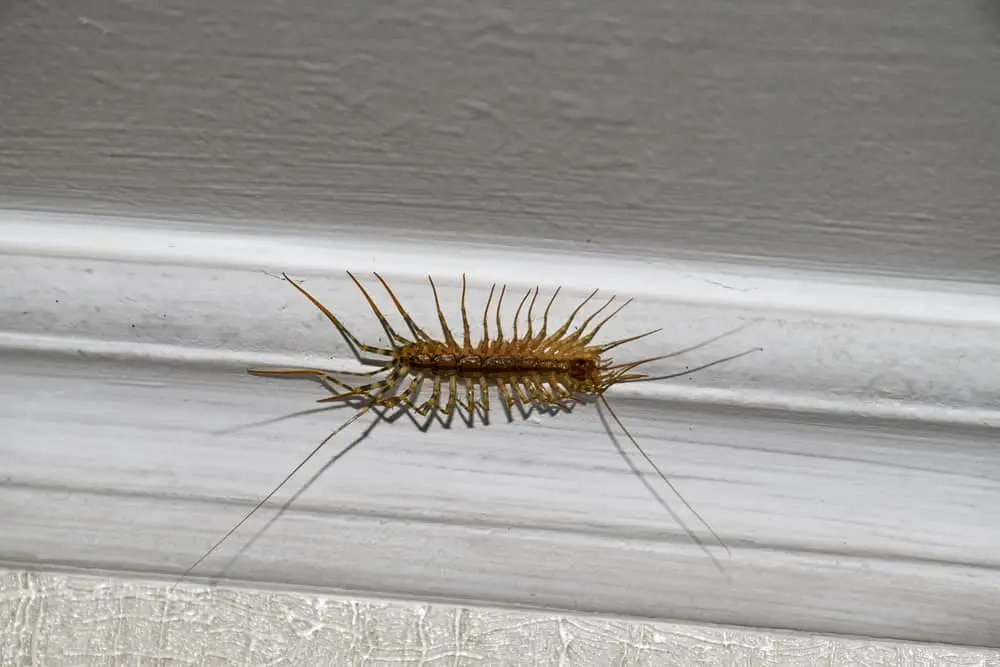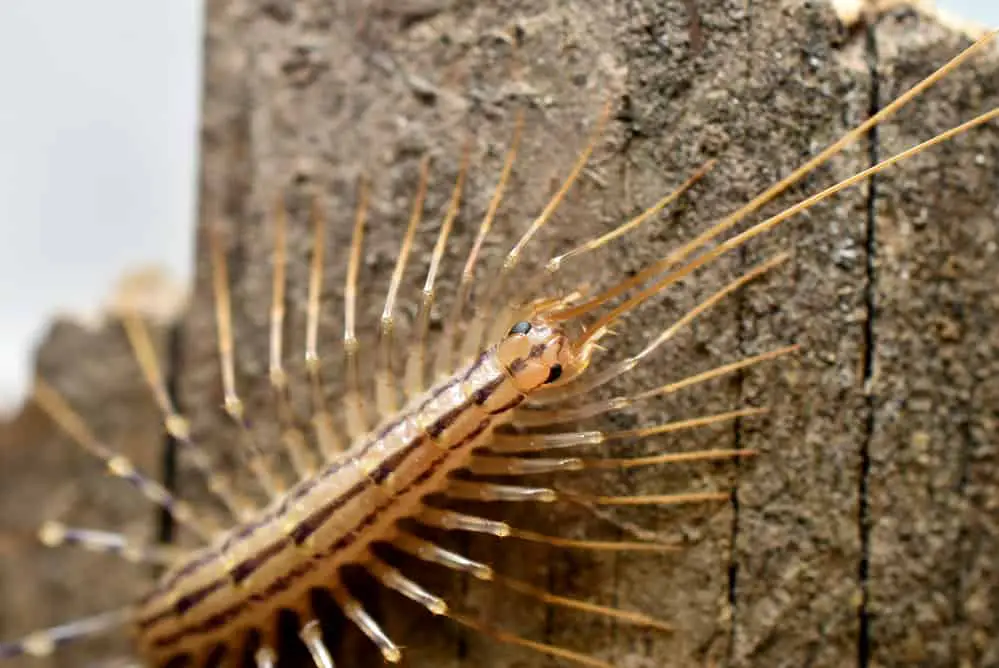Creepy crawlies lurking around at night are the stuff of nightmares. The scuttle of shadows we trace out of the corner of our eyes as we flip on the bathroom or kitchen light. Cockroaches and House Centipedes (Scutigera coleoptrata) darting out of sight or crawling onto our beds can leave even the bravest laying awake at night.
We know that we share our homes with arthropods and insects, various pests that look for water, food sources, and hot, humid shelter. Centipedes, although only a few inches long, have so many pairs of legs and can be hard to keep out of our houses, pipes, and even beds!
Will House Centipedes Climb Anything?
With so many legs, it is obvious that centipedes can climb. They can climb up beds and climb rough metal and wooden surfaces. They cannot climb extremely smooth surfaces like glass or porcelain unless they are covered with glaze or have cracks.
Most of our surfaces are climbable to house centipedes and other many-footed arthropods. If you run a hand over the surface and you feel any ripples or cracks, then that is a foothold and climbable to these creatures.
Surfaces House Centipedes and Insects Can Definitely Climb
- Wood – Most wooden materials have some rough surfaces, no matter how well it has been finished. With the exception of finely sanded and varnished sculptures, most wood in our homes will be easy to climb for insects and centipedes.
- Fabric – Cloth, drapes, and curtains can all be climbed by hook-footed pests. Fabric not only gives centipedes a way to climb but also provides a place to hide and a source of food. Insects like ants, a common meal for house centipedes, are readily found in fabrics where we may not see them, but these predator bugs sure can.
- Unfinished Metal – Metal that does not have a smooth finished exterior can have tiny grooves that centipedes will climb. Often bumps, paint globs, and sloppy welds can give insects a foothold where they otherwise might have been unable to climb.
- Rough Plastic – The way most plastic is manufactured leaves rough lines and edges. Getting a perfectly smooth finish on plastic requires costs that only high-end manufacturers are comfortable paying. Plastic desks, chairs, and shelves all can easily be navigated by these pests.
- Drywall – Almost no home walls are virtually smooth. Drywall paint and textures are bumpy and have ridges that can be exploited by climbing pests. Some drywall made for high humidity environments is very smooth to prevent excessive moisture, like bathroom ceilings and walls. But most of the walls are not finished so.
- Brick and Stone – While it may seem obvious most brick and stone can be scaled by pests. The holes in the stone can even be used as a centipede house where they can hide and stalk prey as well as breed and lay eggs.
- Textured Surfaces, WallPaper, and Furnishings – Covering your walls with any texture or most wallpapers will give a way for centipedes to climb. Hanging furnishings like macrame and plants can also be climbed by indoor pests searching for food.
Surfaces House Centipedes and Insects Can Definitely Not Climb
- Porcelain and Ceramics – Tubs, toilets, and sinks have long trapped the bathroom prowler. Insects, centipedes, and spiders all fall victim to climbing out of a pipe in search of food, only to languish in a porcelain tomb.
- Smoothly Finished Metal – Stainless steel sinks, pots, and tubs all have a surface that is unclimbable. Pests will have a hard time climbing out of the kitchen sink or into a big hot stainless steel pot of food left out overnight to cool.
- Smooth Glass – Windows and shower glass is usually smooth. Frosted shower glass with a texture or bumpy finish can be climbed, but the straight, smooth panes of glass are pest-proof.
- Uncracked Smoothed Marble and Granite – While most rocks and stones have rough exteriors, some highly polished quarry minerals can be seamless and smooth. If a counter, wall, or column is fissure-free, polished stone, then chances are bugs won’t be able to climb it.
- Smoothed Resin Surfaces – Resin furniture and wall art has become more and more popular. The smooth nature of the epoxy makes it an unlikely surface for pests to climb successfully.
- Highly-Glossed Plastic Surfaces – Wallpaper or movie posters with a highly glossed finish are not climbable by centipedes. If the poster or paper gets damaged, cracked, or wrinkled, bugs will be able to climb it eventually.
Where Are House Centipedes Found?

Like most pests that get inside, a centipede house can be varied and numerous. They can be found under baseboards, in nooks in the walls, and in cracks and crevices. Behind cupboards, beneath furniture, and inside attics, crawl spaces, and walls.
Instead of finding the exact location of a centipede house, let’s look at the habit that centipedes need to feel safe and thrive. Understanding what attracts a centipede to your house and the inlets of centipedes can help you find out where they are hiding and how to deal with them.
What Attracts Centipedes to Your House?
Like all creatures, centipedes are driven by three basic needs: Food, water, and shelter. Our homes have everything that a young centipede needs to live a long and fulfilled life, and they will move in if you let them.
| Attractant | How Centipedes Find It | Where You Can Check |
| Food | Most predator arthropods hunt with body temperature and heightened vibrational senses | Check entry points where other insects are frequently present or dead insects are common |
| Water | Antennas and tiny hairs pick up the barometric pressure of moisture and water in the air | Pipes, leaky areas, and damp, moist, high-humidity spots in and around your home |
| Shelter | Body heat and feeling for dryness help centipedes find safe places to rest and breed. | Under baseboards, beneath beds, and in closets are common places for centipedes to seek shelter |
Food – Centipedes are predators and eat other bugs and insects that are smaller than 2 inches in size. Some common favorites are ants, spiders, millipedes, cockroaches, and other centipedes. Anything centipede legs get wrapped around can find itself as the next unfortunate meal.
If a centipede bites a person, it is not for a meal but as a defensive measure, although this is not very common. Some pain, slight swelling, and a bump on the skin may result from a centipede bite.
Water – Leaky pipes and water damage are the quickest ways to attract pests like centipedes. Check your plumbing and under the sinks on a regular basis to reduce the inlets of centipedes.
Shelter – Female house centipedes need a place to lay their eggs and will seek shelter. Cold weather will drive centipedes and countless other pests into your home and even into your bed, where your body heat radiates out like a beacon.
How to Keep Centipedes from Climbing in Your Room?
The only way to keep the average centipede out of your home is to employ regular pest control practices. In order to prevent pest infestations, a routine of cleaning, organizing, and pest eradication needs to be implemented.
- Cleaning – A dirty room has a much higher chance of attracting insects, bugs, and other opportunistic scavaging pests. Food crumbs will bring the pests that centipedes eat. If you keep your house clean and the dirt and food debris to a minimum, then centipedes will look for an easier food source and leave your room alone.
- Organizing – It is common to move things into a home once and leave it in the same spot for a long time. If this happens, especially behind fridges, stoves, furniture, and washers/dryers, dirt, filth, and carcasses can build up. Centipedes will nest near this to have access to the treasure trove of food. Rearrange and organize your clutter regularly to have access to all areas of your house and keep pests at bay.
- Pest Removal – If steps one and two have been neglected for too long, then there is a good chance that a pest removal or extermination plan is needed. If only a few pests are present, catching and removing them is a perfectly acceptable method to be free of them. If, on the other hand, the infestation is serious, you will need to take more drastic action.
- Clean and remove all visible food sources and pest attractants. Centipedes are drawn to other insects and pests they can eat but will avoid coming into a room where there is no source of food. Cleaning also covers scents and masks odors that some centipedes use to hunt.
- Place boric acid in the form of borax powder near any openings, cracks, or crevices where centipedes or other pests are common. Boric acid attacks centipedes and other invertebrates by dehydration through the exoskeleton whenever and wherever contact is made. When ingested, boric acid destroys the digestive system of centipedes.
- Use a dehumidifier and exhaust fans to reduce air moisture in problematic rooms. Centipedes like hot, humid habitats, and using a dehumidifier can make the air unpleasant for them to breathe. Doing this in bathrooms, attics, and basements can reduce the places centipedes have to nest and drive them out of your home.


